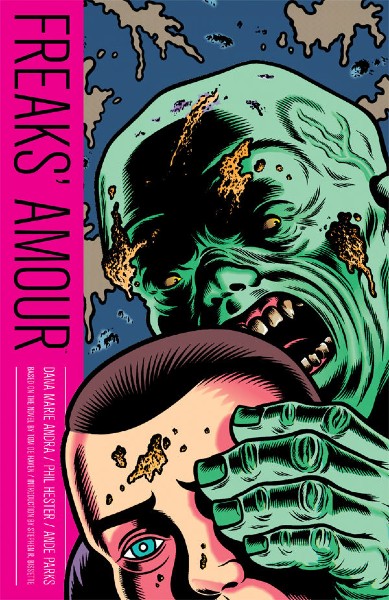A Very Jersey Apocalypse: On “Freaks’ Amour”
A graphic novel adapting the novel "Freaks' Amour" had a stunning array of talent involved. How is it?

The sheer array of talent involved in adapting Tom De Haven’s 1979 novel Freaks’ Amour into comics form is staggering. Phil Hester and Andre Parks are responsible for the searing art found within; Charles Burns illustrated the cover, which features an altered human face and a stylized mask. Burns’s attention to detail and fondness for the grotesque makes this a face that wouldn’t be out of place in his own Black Hole, a book that reckons with some of the same themes as Freaks’ Amour to very different ends. And there’s a short adaptation of part of De Haven’s book written and drawn by Gary Panter as a kind of bonus feature in this edition as well.
Read either version of Freaks’ Amour and you’ll get a sense of just how ahead of its time De Haven’s novel was. In his introduction to the graphic novel, Stephen R. Bissette cites a number of books that De Haven’s seems to anticipate, including Katherine Dunn’s Geek Love. The pulp stylization of this narrative includes an explosion on Blofeld Street; that choice of De Haven’s anticipates Percival Everett’s later upending of James Bond-related tropes in the book Dr. No.

De Haven’s novel is out of print, though there’s an excellent case to be made for some enterprising publishing imprint to give it the deluxe reissue treatment. The premise: a mysterious explosion on a Jersey City block causes the people and animals in the vicinity to be altered in random and bizarre ways. (This also predates the Wild Cards series by several years.) Protagonist Grinner’s father, for instance, is transformed by having one of his arms dramatically extended; this is comparatively mild, all things considered.
The novel is set several decades in the future — around 2010, to be specific. Grinner and his wife Reeni have made a career out of doing sex work: essentially playing out rape fantasies on stage to audiences of people unaffected by mutations. In doing so, they hope to make enough money to pay for an operation that will radically change their appearance, allowing them to pass for “normal.”
So, two things about Freaks’ Amour. The first is that both novel and graphic novel are unrelentingly bleak. Grinner isn’t exactly an unreliable narrator, but his resentment of the world around him causes him to lash out at everyone around him, sometimes violently. Reeni, meanwhile, has developed an addiction to the eggs produced by mutant goldfish that temporarily kill their user, then revive them several hours later. That Grinner’s brother Flour is involved in the distribution of this drug makes matters even more complicated.
The other quality is that, in 2025, the novel reads like a metaphor for dysphoria. Or maybe “metaphor” is a step too far: this is literally a book where the vast majority of the characters are alienated from their bodies and know, full stop, that they’re living in shapes that are different from what they should be. De Haven is not transgender, but it wouldn’t take much effort to come up with a trans reading of Freaks’ Amour.
In fact, the graphic novel has precisely that in one of its afterwords, by Dana Marie Andra, who adapted the novel into a new medium. (She’s also kept busy in the years since then; in 2024, an anthology of horror comics that she edited was published to glowing reviews.) Andra is trans; in her afterword to the collecred edition, she wrote that “I see my own struggle reflected in these characters.”
That entire afterword is compelling reading both both Andra’s candid tone and her analysis of De Haven’s novel. “[W]hat captured me as a reader and as one afforded the privilege to adapt it to comics, was the emotional subtext that motivates its characters,” she writes in the afterword — before adding that four of the book’s major characters “suffer from intense body dysphoria.”
The story behind Freaks’ Amour is deeply compelling, but how’s the book itself? It’s very good — Andra’s adaptation of De Haven’s book preserves much of its tone, but it doesn’t feel as though you’re simply reading an illustrated version of the text. In the aforementioned afterword, she also mentions that this wasn’t her first time adapting prose for comics; she’d previously written an adaptation of the story "Miss Gentilbelle" by the great Charles Beaumont.
What’s most jarring about this book in both incarnations is how unremittingly bleak it is: for all of the pulpy and science fictional touches, this has far more in common with existentialist crime fiction than anything else.
Hester’s pencils and Parks’s inks also go a long way towards making this story feel lived in. I’ve long admired Parks’s work as an artist, whether he’s telling stories of superheroes (Green Arrow), weird science (Shipwreck), or stories that mash genre conventions together (Foot Soldiers). He makes memorable use of grids here, including some nine-panel pages in which Grinner and Reeni’s body language relative to one another says as much as their dialogue. Parks’s inks add a stark moodiness to these black-and-white pages, creating mysterious depths in some spaces and putting certain characters into a sharp relief.
Freaks’ Amour isn’t always an easy read: it’s about people who care about each other and yet treat each other terribly. But that unease has plenty of surprises in store: a science fiction story concealing a horror story concealing a crime story. Novel and graphic novel both should be far more widely read; there’s a stunning amount of talent involved in this project, and it shows.